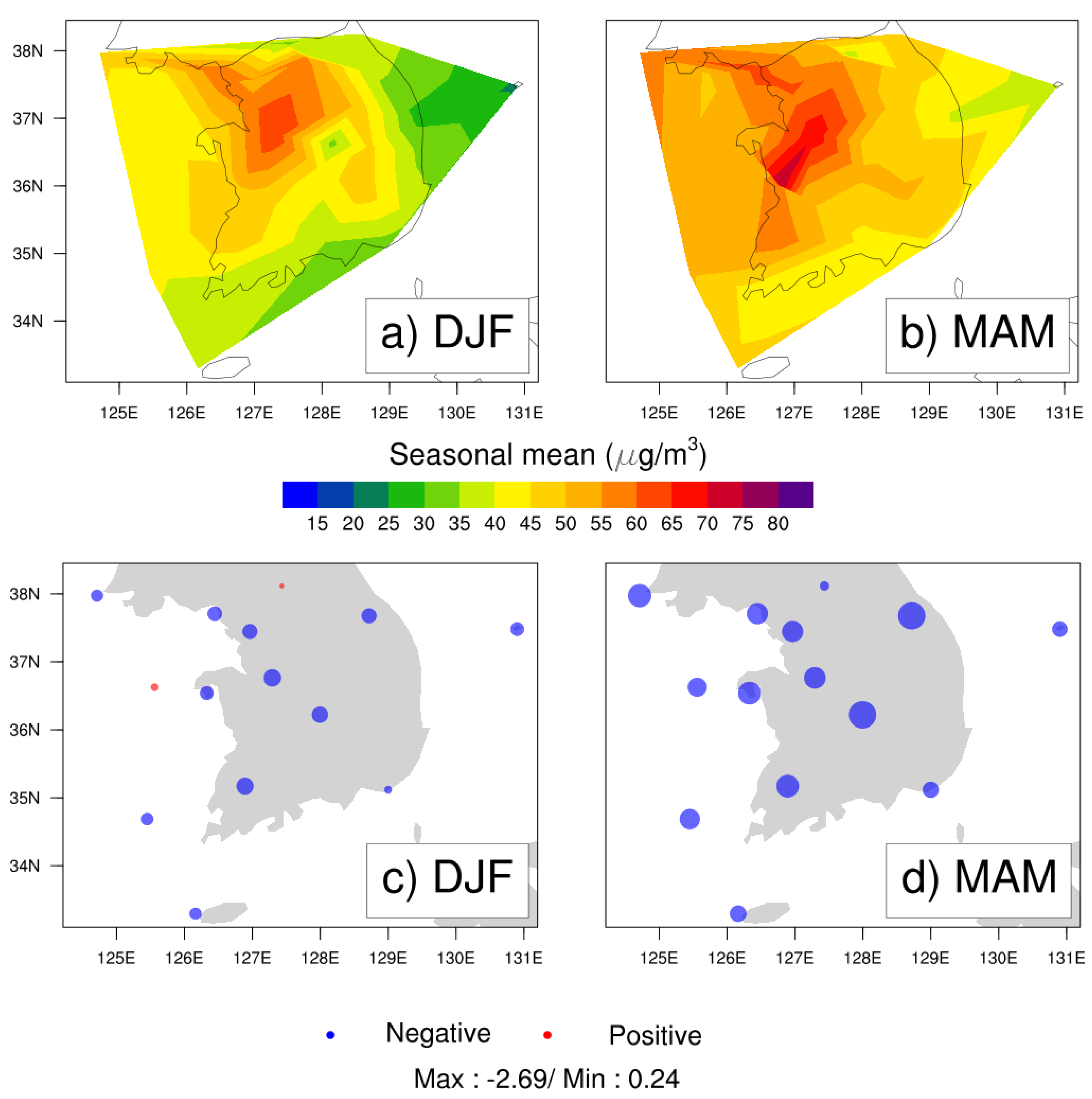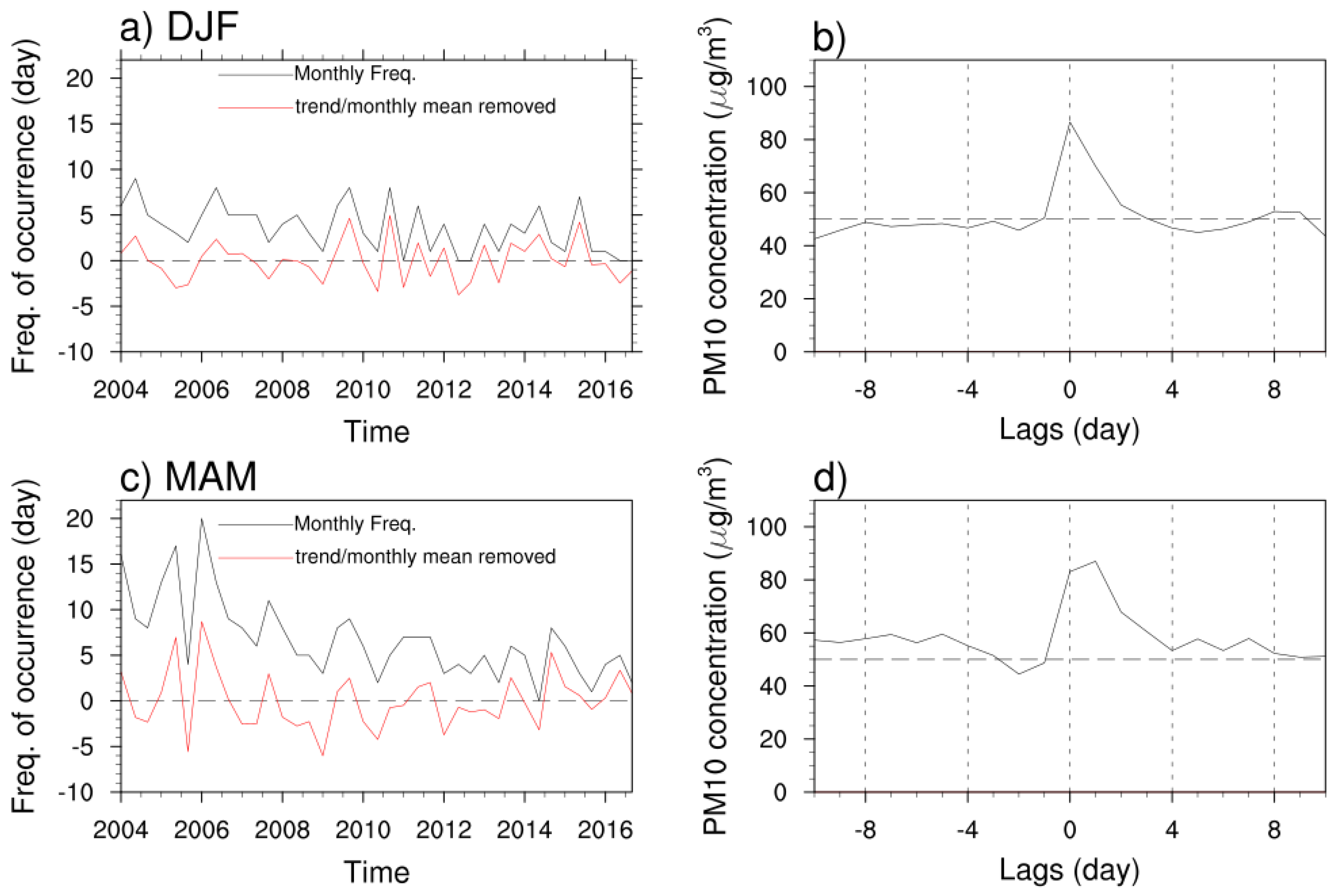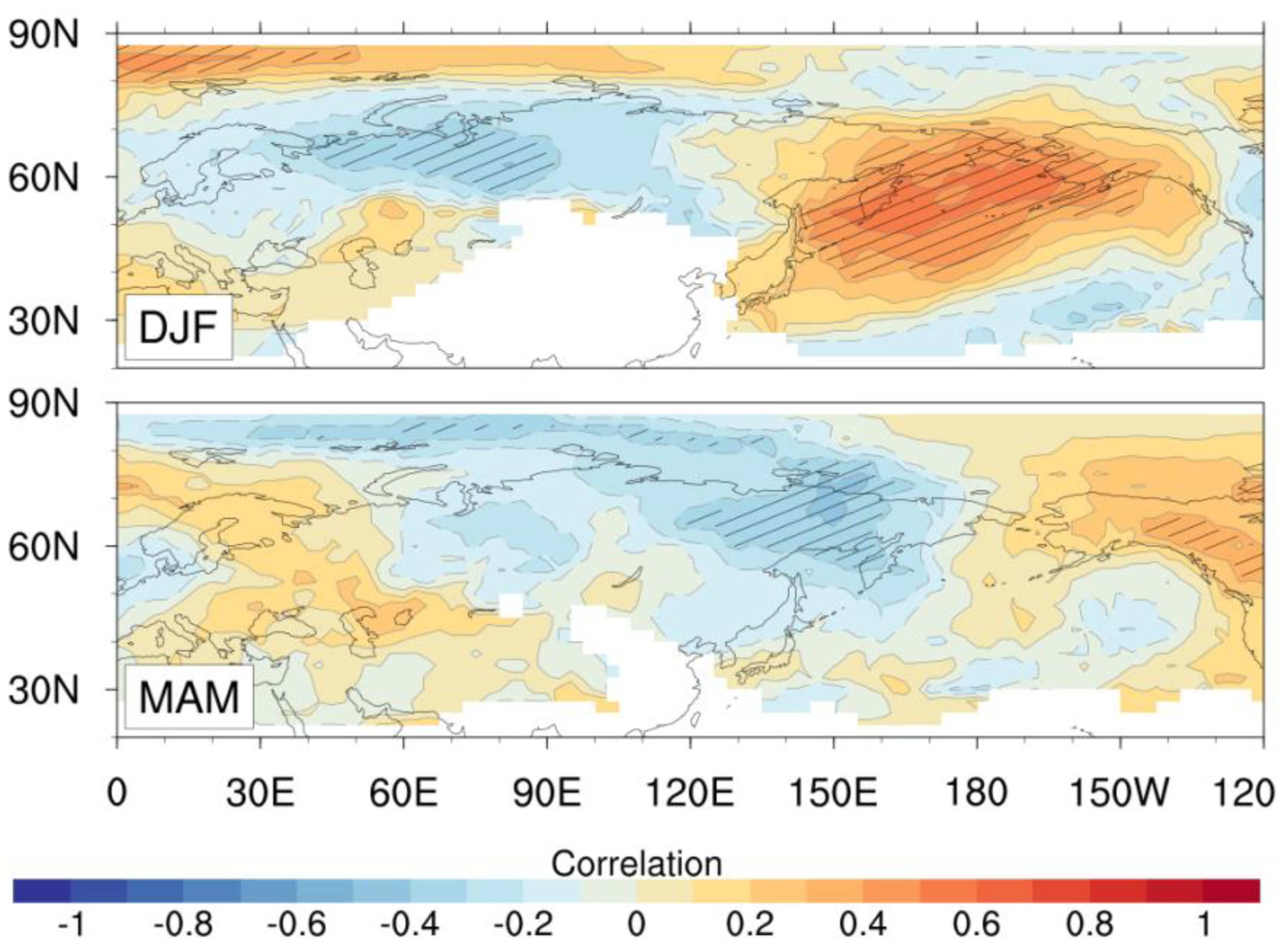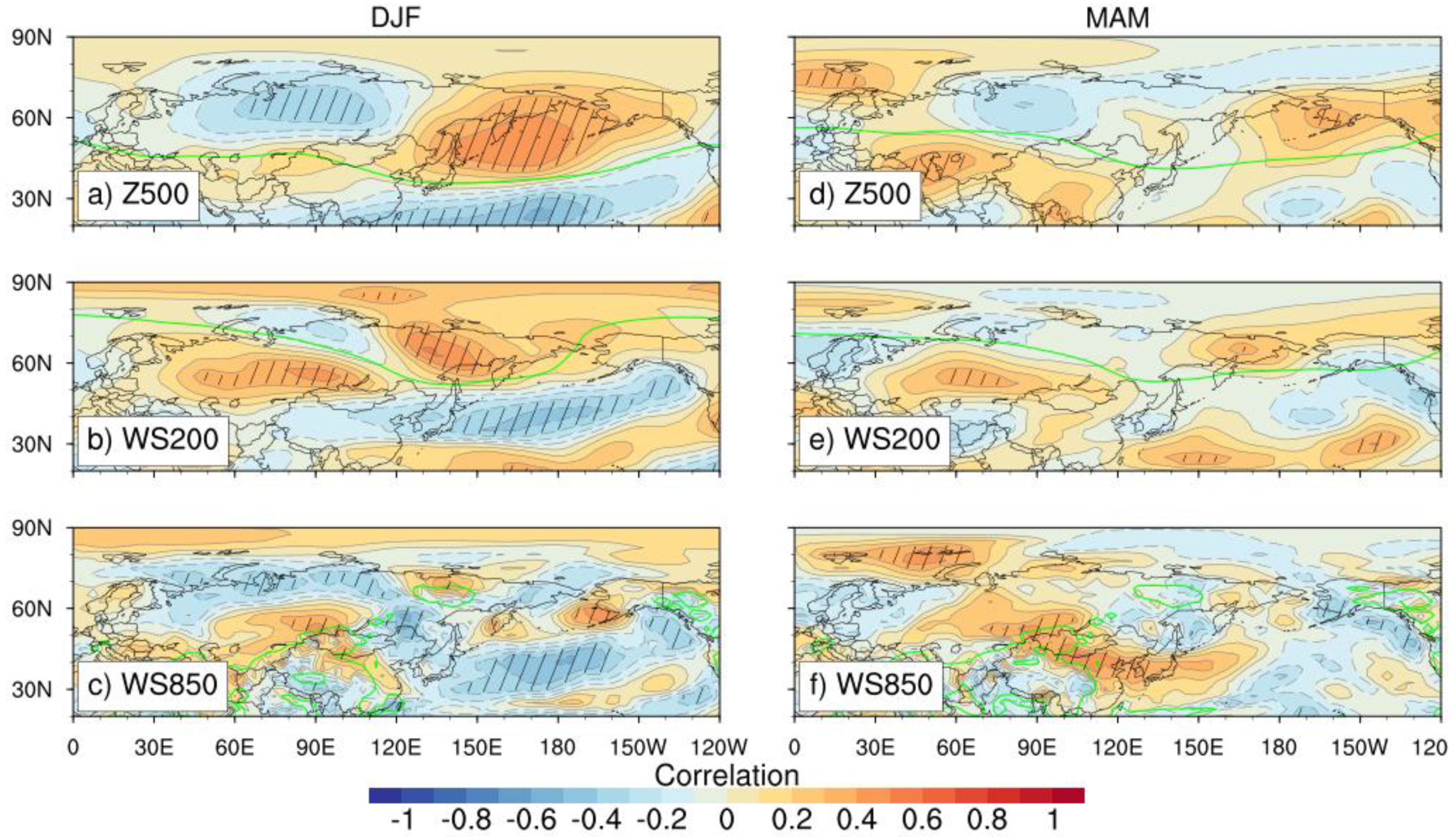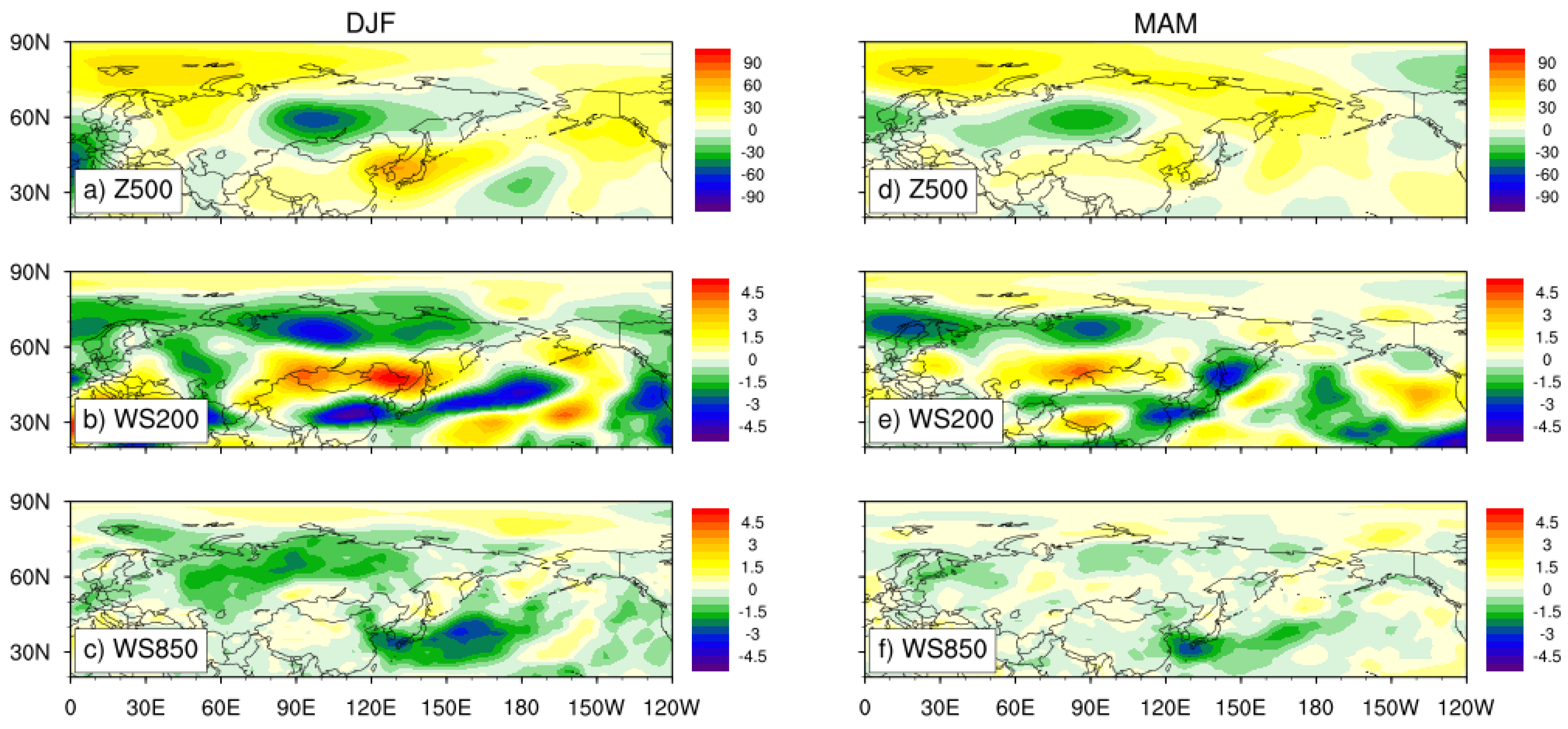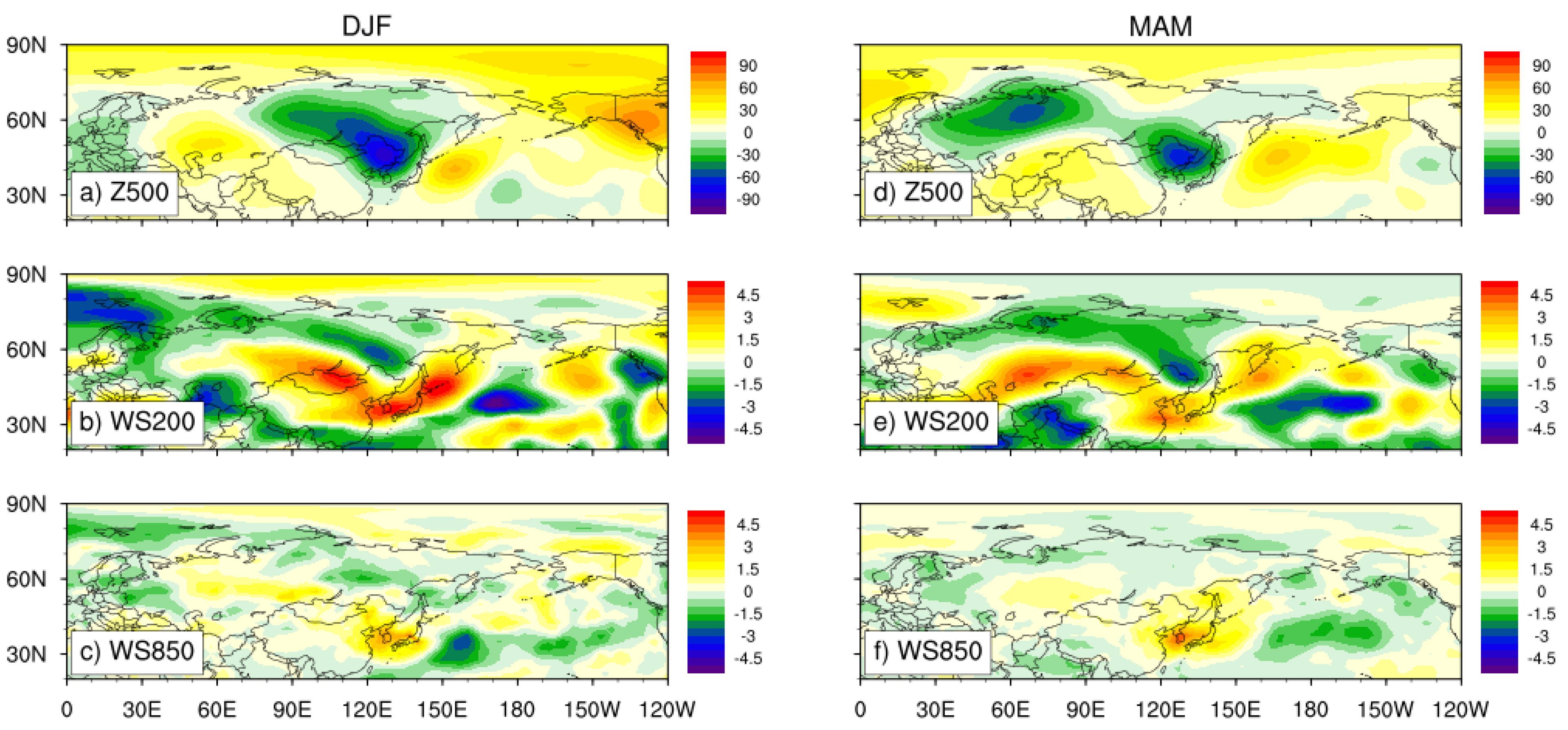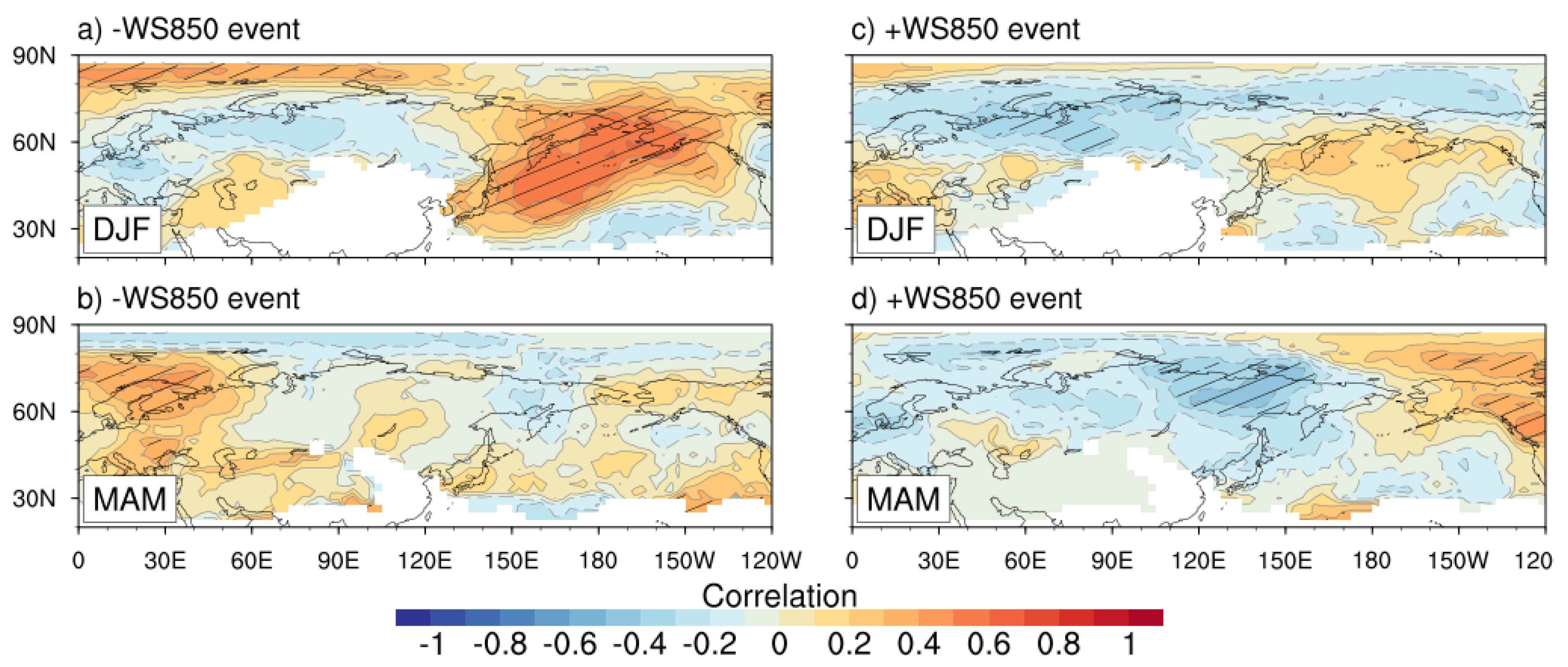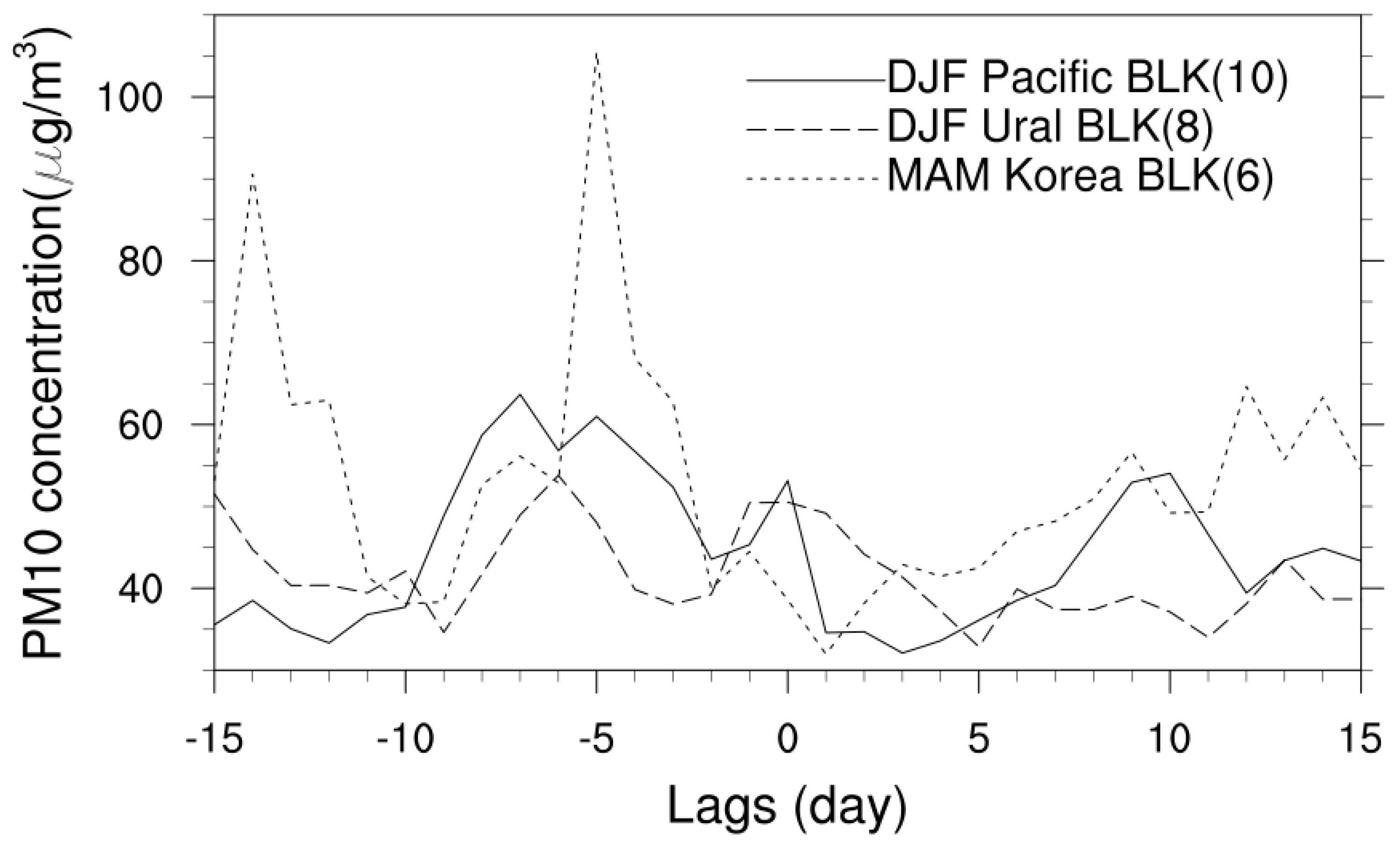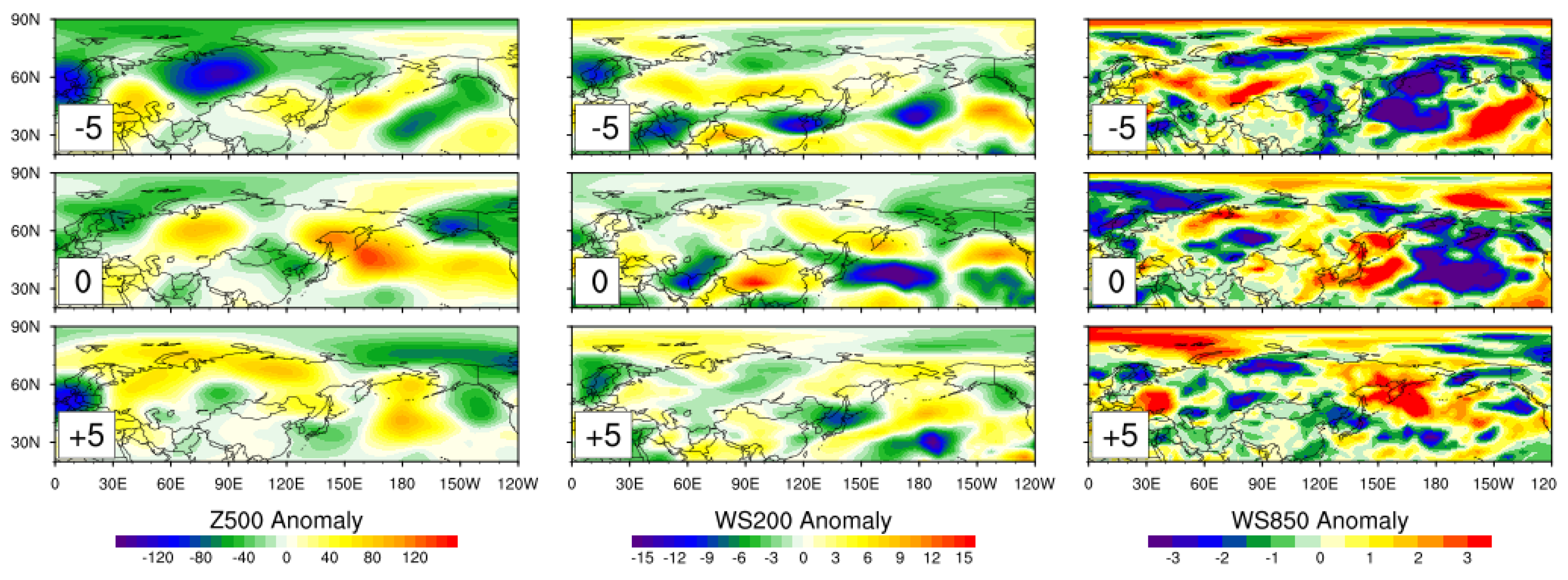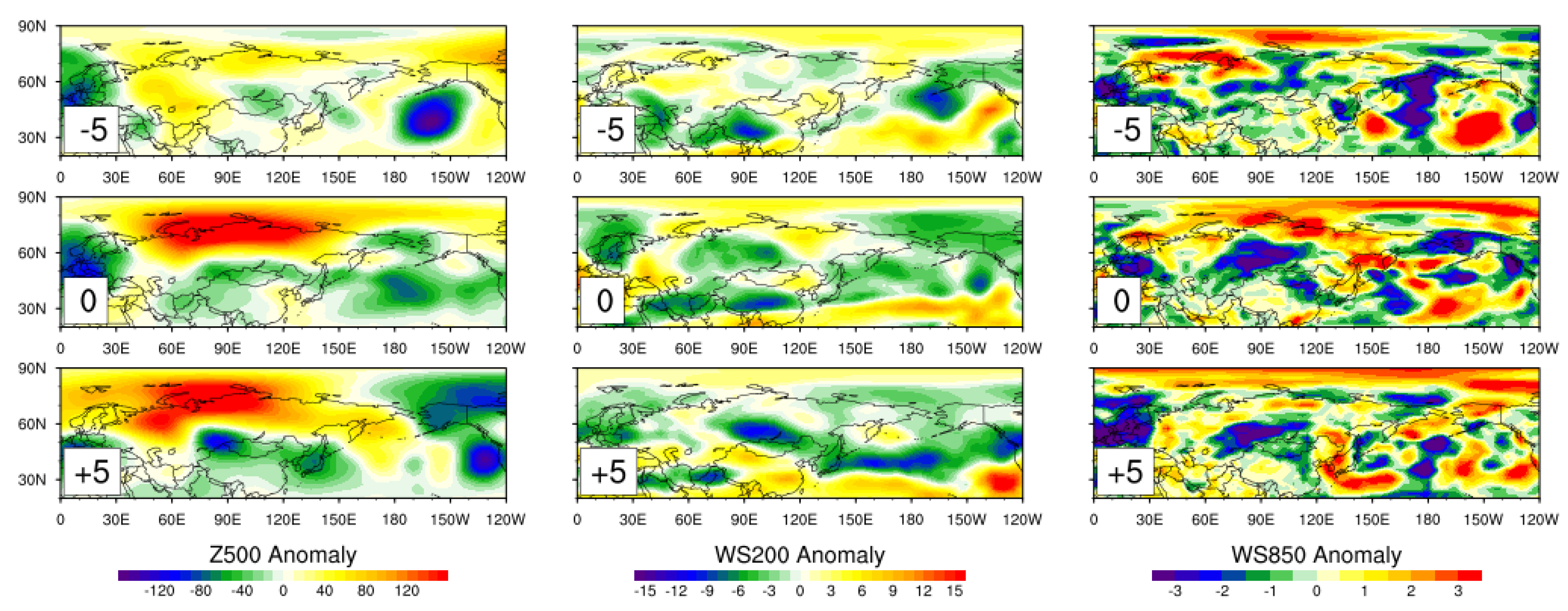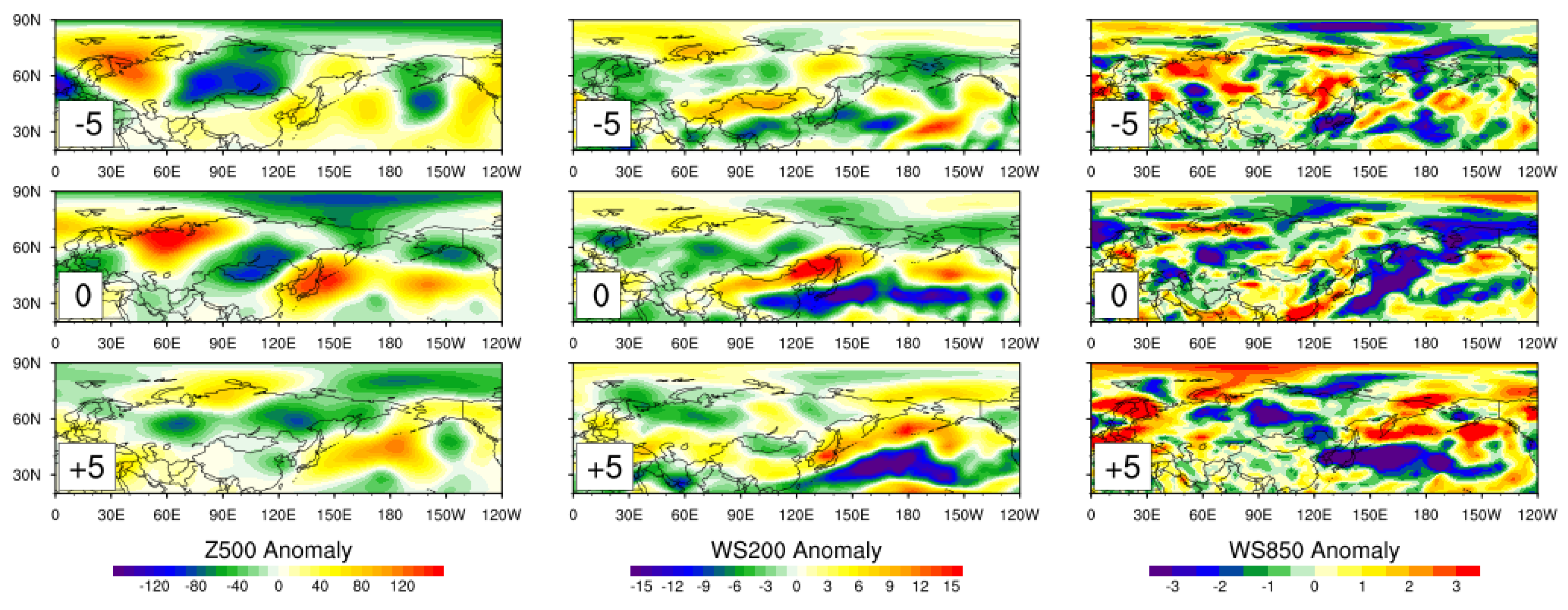3.1. PM10 Concentration over Korea
Figure 1 shows the seasonal mean concentration for all stations and the seasonal regression coefficient for the targeted stations. The regression coefficients were obtained from the monthly mean concentration within a given season. From 2004 to 2016, PM
10 concentrations are on the decline, but the average concentration in the metropolis (37.5° N, 127° E) and Chungcheong (36.5° N, 126.5° E) is higher than 50 μg m
−3 in both spring and winter, presumably due to urbanization and industrialization (
Figure 1a,b). The southern and eastern regions of Korea maintain lower concentrations as compared with the west, but in spring (
Figure 1b), the national average is higher than 40 μg m
−3 or higher except for Ulleung-do (37.5° N, 131° E). In addition, the number of forest fires that can affect local PM
10 concentrations reaches 300 events per year in spring and winter (Statistics of Forest Fire by Korean Statistical Information Service;
http://kosis.kr/eng). Moreover, Gong et al. [
27] found that PM
10 emissions increase during times of high energy use. An abnormally high concentration in a few areas causes the national average to rise. To prevent sampling local events, the high PM
10 concentration events, defined in
Section 2, will be used in our analyses. Even if the concentration is high in some areas, such as the Seoul and Chungcheong, observatories in other areas must also meet the criteria, so it can be detected whether the concentration has increased nationwide.
An index using a percentage of stations that meet the criteria in
Section 2 is used to exclude the local effects. Blocking does not only affect a certain area because it is a large-scale phenomenon. On days with bad air quality across the whole country, the impact of blocking can be clearly identified only when the local air pollution is initially excluded. However, if the high PM
10 event date is selected based on the national average of concentration, it is likely that local pollution will be recorded as a national pollution.
Figure 2 shows the characteristics of the high PM
10 concentration events. The black line in
Figure 2a shows the monthly frequency of the high PM
10 event, indicating how many days with high PM
10 concentration are detected during a month. The red line shows the monthly frequency of the high PM
10 event with the monthly mean and the linear trend removed. Events occur more frequently in spring than in winter, and were especially more frequent from 2004 to 2008 (
Figure 2a,c). However, in spring, the negative trend is steeper than that in winter, which is consistent with the greater regression coefficients of spring in
Figure 1d.
Figure 2b,d illustrate the mean concentration changes about the targeted station for the onset date of the high PM
10 event. At the onset day of the event, the concentration increases by about 40 μg m
−3 and then recovers. Spring has a longer event duration than winter.
3.2. PM10 and Blocking
We examine whether blockings are associated with the PM
10 concentrations in Korea.
Figure 3 displays a seasonal Pearson correlation map between the monthly blocking frequency and the frequency of the monthly occurrence of high PM
10 concentration events in Korea. The monthly blocking frequency is calculated by counting how many days of blocking were detected each month at each grid point. The white area with no value on the map is an area where no blocking occurred during the study period. The linear trend and monthly mean are removed from both the monthly blocking frequency and monthly frequency of high PM
10 events. When the same test is carried out without removing the linear trends and monthly mean, the values are shown to be approximately 0.1 lower in the North Pacific, but the differences in other areas are small.
In winter, positive and significant correlations between the North Pacific blocking and the nationwide fine dust pollution in South Korea are found (
Figure 3, top panel). There are positive correlations values of 0.3 to 0.6 in the North Pacific, including the Korean Peninsula. In addition, there are negative correlations of −0.2 to −0.4 in northern Eurasia (50–80° N, 30–120° E). Blocking in the eastern part of the Ural region (60–90° E), which is known to affect cold waves in Korea, shows high negative values. Correlations between the Ural region, the central Pacific, and the Korean Peninsula exceed the 95% confidence level, showing high reliability. These results suggest that in winter, there were frequent high PM
10 events in the months when there were frequent blockings in the Pacific Ocean, while in the months when there were frequent blockings in Ural, there were fewer high PM
10 events in Korea.
In spring, negative correlations are apparent near the Kamchatka Peninsula (70° N, 150° E). However, the values are smaller than those in winter. The difference between the correlation patterns for winter and spring suggests that the impact and/or importance of blocking on the high PM10 events may vary by seasons. To address this, we next examine atmospheric fields associated with the high PM10 events.
In
Figure 4, to investigate the atmospheric circulation pattern when the high concentration event occurred, the correlation between the monthly anomalies in the 500 hPa geopotential height, 850 hPa wind speed, and in the 200 hPa wind speed and the monthly frequencies of the high PM
10 events were identified. The seasonal cycle and the linear trend were eliminated from both the event frequency and the atmospheric variable anomaly. But the results are almost the same when the was test carried out without the removal of the seasonal cycle and trend.
Winter features are consistent with the preceding research by Lee et al. [
5] and Lee et al. [
24], whereas for spring, despite the same high PM
10 event, the agreement with the previous studies is poor. For instance, the 500 hPa geopotential height anomaly has a high correlation of 0.2 to 0.5 from 60° E–150° W, including the Korean Peninsula (
Figure 4a). There is also a strong negative correlation of −0.2 to −0.5 in Siberia (50–80° N, 30–120° E). On the other hand, in spring (
Figure 4d), negative correlations of −0.3 to −0.4 are observed along the Far East Asia coast and in Siberia, and positive correlations with similar amounts of intensity in western China (20–50° N, 30–100° E). Except for the northern and central regions of China (30–45° N, 90–110° E), the 850 hPa wind speed is dominated by negative correlations throughout Eurasia and the Pacific region (
Figure 4c). In spring, however, the midlatitudes show a positive correlation from the interior of Eurasia to the western Pacific, especially in the Chinese coastal region having a very high correlation of 0.5 to 0.6 (
Figure 4f). The 200 hPa wind speed anomaly has negative correlations both in spring and winter in Pacific and Korea, while the inland areas, including northwest of Mongolia (40–50° N, 90–120° E), have positive correlations. In winter, China (at 40° N), the Korean Peninsula, and the Pacific Ocean are characterized by a negative correlation of −0.2 to −0.4 (
Figure 4b). However, in spring, the northern part of the Korean Peninsula and the Pacific Ocean are associated with a weak and negative correlation of −0.1 to −0.2, and the entire Eurasian continent and south of Korea has a positive correlation of 0.2 to 0.4 (
Figure 4e).
In Korea, when high PM
10 events occur, the atmospheric fields, in winter, showing high pressure, and upper and lower wind speeds are weak, consistent with Figure 3 of Lee et al. [
5]. Such weather systems form an environment favoring transport of PM
10 from outside or accumulation of PM
10 in the country. In addition, the low pressure system in Siberia increases the frequency of dust storms in the desert. Moreover, the west wind is strengthened by the low pressure system over Siberia and the high pressure system in the Pacific Ocean, which transports desert dust to the Far East Asia [
24]. Enhanced 200 hPa wind speeds near the northwest of Mongolia are shown in
Figure 4.
An analysis by Lee et al. [
5] reported that high concentration events take place through the accumulation of contaminants and congestion when domestic wind speed weakens. However, the impact of domestic wind speed on PM
10 in spring and winter shown in
Figure 4 is the opposite. In winter, strong wind speed causes high PM
10 events, while in spring, weak wind speed leads to a similar effect. Considering these differences, the effects of blocking were investigated in more detail showning that the blocking effect on high PM
10 events is stronger for a weak average wind speed in Korea.
In order to investigate the differences between strong wind speed events and weak wind speed events in association with high PM
10 events,
Figure 5 and
Figure 6 illustrate 500 hPa geopotential height, 850 hPa and 200 hPa wind speed daily anomalies for both event types. The two event types were defined by classifying high PM
10 events into groups with negative (−WS850 events;
Figure 5) or positive (+WS850 events;
Figure 6) average 850 hPa wind anomalies over Korea.
Both types of events have the opposite characteristics except for low pressure in Siberia and strong upper wind speeds in Mongolia. During the –WS850 event, independent of the season, a high pressure system is located over Korea (
Figure 5), while the height anomalies during winter are stronger than those of spring. The 200 hPa wind speed anomaly is positive in the west and north of the Korean Peninsula, including the Taklamakan desert (40–45° N, 80–100° E) and Mongolia. However, over the Korean Peninsula, a negative anomaly is shown. In contrast, Korea is under the influence of a strong low pressure system located around north of the Korean Peninsula during the +WS850 event, while higher wind speeds at 200 hPa and 850 hPa pressure levels can be seen throughout the inner Mongolia and China (
Figure 6). Upper wind speeds show positive values in desert areas, northern China, and the Far East Asia region, including South Korea. These characteristics are also shown in
Figure 4. In other words, the features shown in
Figure 4 do not appear only in certain seasons, but in both seasons. Therefore, one can conclude that the high PM
10 events can occur under the influence of both low and high pressure systems. The upper and lower wind speed can be both weak (−WS850 event,
Figure 5b–f) or strong (+WS850 event,
Figure 6b–f). With respect to the event duration, the −WS850 events are longer than the +WS850 events (
Table 1) and the −WS850 events have an average duration of 2.26 days in winter and 2.46 days in spring, while they are respectively 1.48 and 2 days for the +WS850 events. The number of cases is similar. However, for spring, the overall average concentration for the +WS850 events is 20 μg m
−3 higher than for the −WS850 events.
Figure 7 illustrates the correlation between the monthly frequency of +WS850 and –WS850 events and the monthly frequency of blocking. Compared to
Figure 4, the −WS850 events show an increase in values along Far East Asia and the western North Pacific, especially in winter, with a correlation of more than 0.4 and a high confidence in the wide Pacific region. Ural blocking decreases its value by 0.1 (see
Figure 7a) and loses its significance. Conversely, for the +WS850 events, shown in
Figure 7c, the Ural region has the same value and significance as in
Figure 3. In addition, Pacific blocking is associated with a positive correlation in a wide area, but with a reduction of 0.3 in correlation and with no significance. In spring, for the −WS850 events there is a correlation of 0.2 in the Far East Asia region, which is opposite to the correlation in
Figure 3. However, the correlation and significance are still low. For the +WS850 events in spring, the pattern of correlation remains similar to that in
Figure 3, and the values over the Kamchatka Peninsula have increased by about 0.1.
3.3. Atmospheric Conditions Associated with Blockings in Various Locations
We have demonstrated that the blocking frequency of occurrence is linked with the high PM
10 event over Korea and that the atmospheric variables for the linkage involves the circulation fields. We now choose blockings over the North Pacific, Ural-Siberia, and Korea to examine its impact on the atmospheric conditions around Korea. For regions with a positive correlation greater than 0.4 and a negative correlation smaller than −0.3 in
Figure 7, Pacific blocking is detected between 120° E and 180° W, Ural blocking between 80° E and 120° E, and Korea blocking near the Korean Peninsula.
Figure 8 shows the average PM
10 concentration of the targeted stations during the 15 days before and after the onset date. In our previous analysis (e.g.,
Figure 3), it is shown that blocking occurrence over the North Pacific increases the chances of high PM
10 concentration over Korea, while blocking occurrence over Ural-Siberia decreases the concentration. When we narrow our analysis to daily evolutions associated with the blocking, we note that the blocking is one factor at synoptic or greater scales that determines the concentration of PM
10. In the case of Pacific and Korea blocking, the concentration increases before and after blocking onset. However, the Ural-Siberia blocking shows low concentrations throughout the lags. Near the onset of the blockings, the concentration for Pacific and Korea blockings are also low, while the value shows a sign of bouncing back from about a lag of 10 days. To examine the meteorological conditions for the blockings, daily composites of 500 hPa geopotential height and 850 hPa and 200 hPa wind speeds are examined below from a lag of −5 days to +5 days for winter Pacific blocking, winter Ural blocking, and spring Korea blocking.
Before the onset of Pacific blocking (
Figure 9), the pressure gradient is strengthened by having a low pressure anomaly form to the north of the desert. During this time, wind speed shows positive anomalies over northern Mongolia and China, which indicate increased chances of dust storms and long-range transport to Korea. These atmospheric fields are consistent with −WS850 events during winter (
Figure 5a–c), explaining the high correlation in the North Pacific (
Figure 7a). At the onset of the blocking event, a high pressure anomaly is likely to be located in Siberia, reducing chances of dust storms, as well as the wind speed over China. Over the Korean Peninsula, a positive wind speed anomaly can be seen, which suggests improved ventilation. On lag +5 days, the average PM
10 concentration increases again. In addition, the wind speed anomaly over Korea shows negative values, as for that on lag −5 days. The height anomalies in the upstream region displays a positive sign over northern Mongolia and China, while a negative height anomaly is seen over Korea. We note that changes in PM
10 concentration and the atmospheric fields associated with the Pacific blocking of spring resemble that of the Pacific blocking of winter (not shown).
In contrast, for Ural Blocking during winter (
Figure 10), we observe that a high (low) height anomaly forms in Ural and Siberia (Mongolia and China) during the onset. This anomaly field weakens the north-south gradient of total height field, thereby reducing the zonal wind speed at both upper and lower troposphere over northern Mongolia and China and chances of dust storms. This contributes to a decrease in chances of long-distance transportation of fine dust from outside. Interestingly, despite the low PM
10 concentration throughout the lags, wind speed shows a negative anomaly over Korea. This is, however, consistent with the results in
Figure 7 that the negative correlation between Ural-Siberia blocking and the high PM
10 concentration event strengthens for the +WS850 events.
Lastly, in the case of Korea blocking (
Figure 11), a wave train-type air pressure field is observed similar to that for Pacific blocking. The concentration increases, similar to Pacific blocking, due to the strong low pressure in Siberia before the onset. However, it is expected that the low pressure in Siberia is distributed over the desert during the Korea blockings, which does not form a strong pressure gradient, unlike the Pacific blockings, resulting in lower concentrations in Korea.
